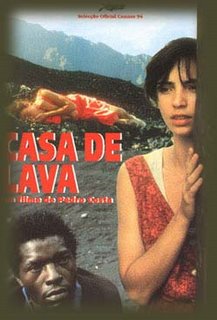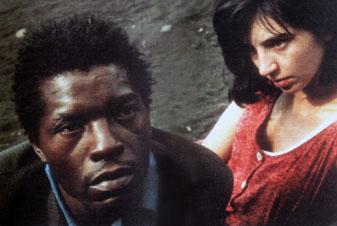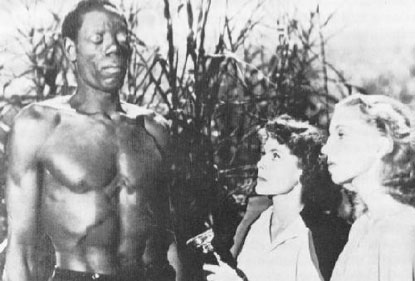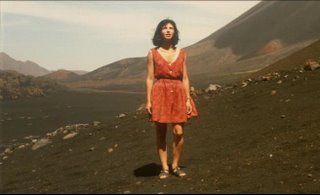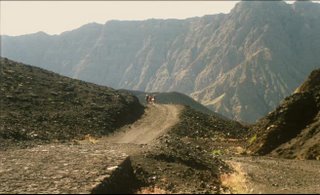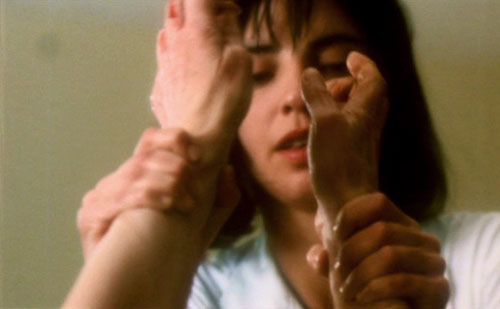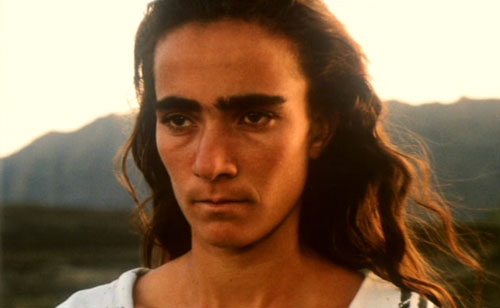In the “Publications and Events” section of this web site, I’ve written, “I don’t know when `A Few Eruptions in the House of Lava,’ my commissioned piece about Pedro Costa’s 1994 CASA DE LAVA, will be appearing in a bilingual or trilingual collection about Costa edited by Ricardo Matos Cabo, the publication of which has been delayed many times. At some point I hope to print or reprint this essay on my site.”
I hope Ricardo doesn’t mind me jumping the gun. I sent him this essay in mid-January, and I’m moved to post it now as a sort of gesture of solidarity with COLOSSAL YOUTH having just appeared on the cover of the the summer issue of Film Quarterly — and James Naremore writing about it inside the magazine as his favorite movie of 2007. (2010 footnote: Ricardo’s collecion has been out for some time by now. It’s very beautiful, even if it’s only in Portuguese.) — J.R.
I know I’d go from rags to riches
If you would only say you care
And though my pocket may be empty
I’d be a millionaire.
My clothes may still be torn and tattered
But in my heart I’d be a king
Your love is all that ever mattered
It’s everything.
[…] Must I forever be a beggar
Whose golden dreams will not come true?
Or will I go from rags to riches?
My fate is up to you.
–“Rags to Riches” (by Richard Adlerand Jerry Ross; sung by Tony Bennett)
In my mind, there isn’t as much of a distinction between documentary and fiction as there isbetween a good movie and a bad one. — Abbas Kiarostami in an interview
“The living are as scary as the dead.” — Tina in Casa de Lava
1. Let me preface my remarks with an embarrassing personal confession, which also could be interpreted as a very long-winded apology. After encountering both Pedro Costa and his work for the first time in Rotterdam in early 2002, when I first saw his amazing Où gît votre sourire enfoui? (2001), I had an opportunity to hang out with him a little at the Buenos Aires Festival of Independent Film three months later. And soon after I returned to Chicago, Pedro kindly sent me subtitled VHS copies of that film and three others — Casa de lava (1994), Ossos (1997), and In Vanda’s Room (2000).
Rather than succumb to my first temptation and look at these right away, I decided to wait, for what then seemed like sound professional reasons. It’s one of the terrible aspects of regular film reviewing that whatever films you happen to see, sometimes including the ones that affect you the most, tend to be forgotten once you have to see dozens or hundreds of other films, most of them terrible, afterwards. And because I knew it was only a matter of time before all of Pedro’s films made it to Chicago and that I’d want to write about them all when they arrived, I decided it was better to wait and then see all or at least most of them at the same time.
Then a few glitches came along to complicate this grand scheme. I hadn’t realized that it would take more than five years for a Costa retrospective to make it to Chicago. Even worse, while enjoying the unparalleled luxury of having unlimited length at my disposal in all the longer pieces I wrote for the Chicago Reader for at least 15 years, I hadn’t foreseen that a decrease in the paper’s ads due to the growth of the Internet might have led to a curtailment of that freedom, which is precisely what happened before I was finally able to write my piece in November 2007. During the five long years that I waited, my assigned length went from unlimited to 1200 words —- an absurdly tight space in which to consider all six of Pedro’s features. And to make matters worse, Ricardo Matos Cabo, the editor of this collection, had meanwhile contacted me half a year earlier, inviting me to contribute something of about twice that length, but not having seen most of the films, I felt I was unable to accept.
Finally, by the time a Chicago Costa retrospective was scheduled, I’d seen Juventude em marca (2006) in Toronto, but not yet O sangue (1989) or the three features that followed it. So I wound up discovering most of his oeuvre backwards and in a hurry, long after many friends and colleagues had written eloquently about it. And while doing so, I found that, even though I simultaneously loved and had to struggle in diverse ways with all of Costa’s films, Casa de Lava, his only landscape film, was the one that blew me away the most. So when Ricardo emailed me again in early January 2008, inviting me specifically to write about this film, as a last-minute entry for his collection — even though neither of us had much time to spare —- I had to say yes. Nevertheless, I hope I can be forgiven for imitating this movie a little by letting improvisation, fragmentation, and somewhat disconnected notes overtake any firm position, sustained argument, or conclusion.
2. I don’t know whether the Tony Bennett song quoted above is the unacknowledged (or perhaps unrecognized) source of the lovely melody played repeatedly by Bassoé (Raul Andrade) on his violin in Casa de Lava or if the resemblance is coincidental. Either way, and whatever the intentionality might be on the part of Andrade or Costa or anyone else, the relation of one to the other reminds me of the relation of Casa de Lava to I Walked with a Zombie and other Hollywood and non-Hollywood films. Some people, unlike me, feel that as a reference point, I Walked with a Zombie provides an obstacle or distraction when it comes to appreciating Casa de Lava rather than a useful key that unlocks some of the film’s treasures. Others feel that Stromboli is a more helpful reference point, whereas for me it is the Rossellini film, with its very different and less politicized form of mysticism, that provides a distraction and an obstacle, whatever its own merits.
There are at least four other Andrades listed in the cast of Casa de Lava, all of them playing children of Bassoé —- one of many factors that suggests that the film, like all of Costa’s other films, is an intricate mixture of fact and fiction. Costa told Mark Peranson in Cinema Scope (issue no. 22) that the film was originally scripted, but “at one point I just left the script behind, because I thought that if I’m going to try to shoot this girl in this new place that’s foreign and dangerous, then I have to shoot it from her point of view,” and “There was a lot of improvisation each day” —- one indication among many that Mariana (Inês Medeiros), the lead character, largely functions as Costa’s surrogate in the film. Nearly all the ethical questions and ambiguities posed about her involvement with the islands’ residents are those raised by Costa’s involvement —- that is to say, his filmmaking — as well. And improvisation is perhaps the most obvious way of raising the existential stakes of these issues. As Costa notes, he and Isaach De Bankolé even came to blows over the latter’s objections as a professional actor to his character Leao having to remain in a coma for most or all of the film. (It’s also my impression — gleaned from the account of a friend who attended Costa’s discussion of the film in Los Angeles —- that Leao, like his rough counterpart in I Walked with a Zombie, never would have come out of his coma at all if it hadn’t been for Bankolé’s objections.)
In the same interview, speaking about O sangue, Costa admits a personal aspect in his concentration on “the three boys, the family” in that film, “because I never really had a family. My mother died early, then I went to live with my father, who then went away. From the age of 14, I was alone…” And I’ve noted elsewhere my impression that all of Costa’s films seem to be about outsiders and improvised families. So it seems to me that the passionate struggle of outsiders to find and maintain makeshift families provide much of the meaning as well as the methodology of his work. Existentially speaking, if one combines this struggle with Costa’s uncanny and always evolving talent for composition and color, the overall aspiration resembles both what Godard has called “the definitive by chance” and the fusion of fiction and documentary sought and found by Kiarostami (especially in Life and Nothing More, Through the Olive Trees, and The Wind Will Carry Us, whose plots also feature strained interactions between big-city protagonists and the impoverished yet exotic villagers they’re visiting).
It also suggests that Casa de Lava may be the film of Costa’s that poses the most constant and furious tug of war between Hollywood narrative and the nonnarrative portraiture of both places and people, staging an almost epic battle between the two. These warring modes become almost magically fused whenever there is a landscape shot with one or more human figures; every time this happens, the film moves into high gear. The film begins with stark island portraits, evocative of films by both Straub-Huillet (their fiery Etna and their actors, sometimes glimpsed from behind or in fragments) and Dovzhenko (brooding and heroic still-lifes), only to shift from there to the shards of a Lisbon narrative. Typically, in the latter stretches, we’re either told too little about what’s happening in order to be able to follow the story or everything we could possibly want to know —- in both cases in a rather mannerist fashion. First we get quizzical fragments and a very oblique narrative, served up almost as directly as the island portraits were —- the sounds and images of a Lisbon construction site, anticipating later Costa films, and then Leao and other construction workers seen before Leao’s accident — including a bit of seemingly choreographed, playful sparring between two of them as they hustle through a doorway, returning to work —- and just afterwards as well. (The accident itself is elided, but we glimpse a coworker reporting it.) Then, shortly after we’re introduced to Mariana, a nurse, with a coworker at the hospital, we get enormous chunks of exposition, dumped unceremoniously into our laps. A doctor speaking to Mariana over Leao’s body concludes, “They say he was sad. His name is Leao. He’s been two months in a coma. Oddly, he’s been discharged. The ticket’s bought. Leao’s going home. A check and a letter from his village, both anonymous. A woman’s letter. Sad.”
Much later in the film, the son (Pedro Hestnes) of a white islander, Edite (Edith Scob), gives a similarly telegraphic account of his mother, himself, and the allotment of funds, again to Mariana, over his father’s grave: “She came after him. She was 20 years old. She was half his age. I never met him. He was a political prisoner. Afterwards, she never went home. She’s been here for years with me. People help her. She likes them, they like her. We live here. Now we get a check every month, his pension, to pay everyone back. They know, they all wait. They all want to leave.”
3. Although I can’t hear Bassoé’s song without thinking of Tony Bennett’s, just as I can’t watch Casa de Lava without thinking of I Walked with a Zombie, each transposition —- if that’s what it is in both cases —- is so radical that there’s a recasting of basic elements and presuppositions. The unhinged and bereft lack of definition of Bassoé, the old violinist — except perhaps for his melancholy “Music is a bitch. I worship her” — makes a mockery of Tony Bennett’s wistful lyrics. And whatever else the man in the coma might be, he isn’t a zombie, much less Tourneur’s more mythical and statuesque zombie Carrefour. As far as we can tell, Leao’s an illiterate Cape Verdean construction worker in Lisbon who has an accident, winds up in a coma, and then, after being taken back to Cape Verde, takes his time coming out of it because even if he has a home to come back to, everyone else is leaving there and no one wants to stay — except, perhaps, for Mariana (if only by default) and Edite and her son. And at least the latter two speak Creole.
Whenever Mariana repeats the phrase, “Speak Portuguese,” to someone on the island, I’m reminded of Arthur Hunnicutt in Hawks’ The Big Sky trying to relate to his French partners as they trek across the wilderness: “Speak English, hoss.” But Mariana has no partners, and consciously or not, she remains a colonialist, perhaps even more than Edite and her son are colonialists, because she hardly gives anything to the islanders. And Costa can’t interrogate her motives for remaining on the island without interrogating his own.
Is the film itself his own patient? And if so, what can Costa do once the film wakes up on its own, without his help or input? Answer: The same thing we can do. He can watch.
4. The film is a suite of denials, one after the other. Bassoé refuses to acknowledge directly that he’s the father of Leao, and other locals refuse to respond when Mariana asks them if Leao is a relative. But Mariana is no less in denial when people ask her directly or indirectly why she isn’t back in Lisbon. Edite’s son puts it the plainest: “Why are you here?” And, like Bassoé, she never answers the question of whom she belongs to and who belongs to her.
Worst of all, she can’t seem to go native as Edite, her doppelgänger, does, maybe because her own self-appointed function on the island is merely to be the caregiver of Leao, who has no clear place of his own on the island, and who can’t even figure out what her exact function is even after he wakes up. Maybe she likes boys, as she puts it to Edite’s son, but unlike Edite, who likes girls as well as boys, she’s pretty much in denial about her sexuality whenever it has to rub shoulders with any sort of emotional commitment. The only emotional commitment she seems to have is to Leao, and this has nothing to do with Hawksian professionalism. In fact, there are no professionals in this movie — apart from the soldiers, who never come back from whatever war they’re servicing, or the doctor in the medical compound, who seems to evaporate about halfway through the picture, or Edite, at least if she qualifies as a professional colonialist. The other characters, so far as we can tell, are all lost children.
5. Leao regains consciousness almost exactly halfway through the movie, although it takes Mariana much longer than that to become aware of this. Even some of the lost children, such as Tina, know it sooner. It would be interesting to know what Costa’s original scenario would have consisted of if Leao had remained in a coma for the remainder of the movie. As things stand, and no doubt because of the improvisation, the film breaks up and gradually atrophies into fragments and miniplots, a little bit like Muriel or Petulia. But, come to think of it, I Walked With a Zombie also winds up subverting the very notion of a consecutive, coherent plot. Here one could almost say that each beautiful composition —- that is to say, each shot —- tells a separate story. Put them all together and they might seem to resemble the lengthy tracking shot that follows Mariana’s stride through the village, at once purposeful and aimless, as various obstructions pass and periodically block our vision. Now we see her, now we don’t — and neither we nor she seems to know where she’s headed.

